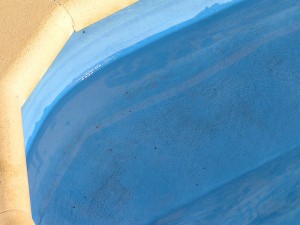Occasionally you may see “stains’ or whitish material on the surface of the paint. This if it happens at all usually shows up 3 – 6 months after application. It will be more visible on darker colours such as Royal Blue, Dark Blue (Tasman), than lighter such as Bondi (Mid Blue) or Sky (Light Blue). Additionally, there may be “stains” above the water line and on adjoining surfaces, such as pavers etc.
Our long experience shows these stains are largely cosmetic and are related to pool water chemistry. They can be found in Salt Water Pools (quite often) Chlorine Pools (sometimes) and those filled with water containing a high mineral content, such as in rural Australia and some cities.
Most pool shop water analysis tests don’t test for these situations, which are caused by impurities.
Usually the result is a white (but sometimes brown, if iron present) precipitate which is seen on the surface and can be wiped off by hand, below the water line. (You will see a glossy paint surface where you wiped your hand) Above the water line there may be stain marks where the water has dried leaving behind a hard residue.
It should be remembered that salt is a naturally occurring mineral and though mostly sodium chloride also has traces of many other minerals. Additionally the chlorinator cell is a chemical factory which also produces by-products from these impurities, such as “scales”, carbonate and sulphate forms which are quite hard. A 50,000 litre pool may have 200 kgs of salt at 99% purity but produces at least 2 kgs of impurities to be deposited on the pool surface often as calcium or magnesium sulfates or carbonates.
In chlorine pools there is not only the effect of natural hardness but also with 65% granular chlorine, which contains 35% calcium carbonate, an insoluble salt, which causes cloudy water and becomes deposited on the surface as scale.
It may also show as “blue” stains on feet or hands and is a result of the abrasive effect of these fine, hard particles and body contact with pool surfaces, “sanding off” some of the paint.
The Langelier Saturation Index ( see related INFO Page in INFO Bank) will provide information as to when scale or precipitations will from and should be used as a guide to prevent it happening. It would be worth discussing with your pool shop.
Usually, to remove the cause, obtain a flocculating or precipitating agent from your pool shop and follow instructions. It may need repeating every few years or after adding more chemicals to your pool.
 |
 |
Our paints are resistant to surface contamination and fungal growth. However over time the surface will tend to change with the attachment of slim and fat build up. This can be removed easily by giving the surface a “wash” with a broom or brush. The most affected areas will be at the water level, and within 300 mm of it. Body fats, suntan lotion and other matter that floats on the water surface will tend to stick to the sides of the pool. A regular scrub in this area should be a part of the maintenance program of the pool.
If you need further guidance contact Hitchins TechnologiesPty Ltd
